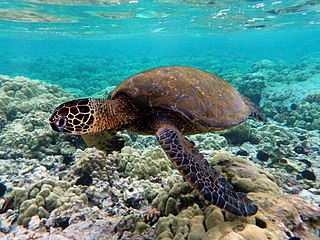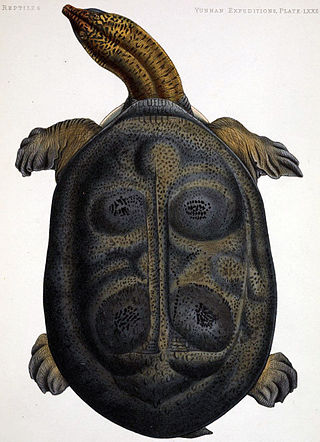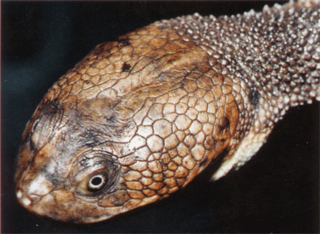See also
- Cheloniology, the study of turtles.
Chelonian has multiple, interrelated meanings:

Turtles are reptiles of the order Testudines, characterized by a special shell developed mainly from their ribs. Modern turtles are divided into two major groups, the Pleurodira and Cryptodira, which differ in the way the head retracts. There are 360 living and recently extinct species of turtles, including land-dwelling tortoises and freshwater terrapins. They are found on most continents, some islands and, in the case of sea turtles, much of the ocean. Like other amniotes they breathe air and do not lay eggs underwater, although many species live in or around water.

Tortoises are reptiles of the family Testudinidae of the order Testudines. Like other turtles, tortoises have a shell to protect from predation and other threats. The shell in tortoises is generally hard, and like other members of the suborder Cryptodira, they retract their necks and heads directly backward into the shell to protect them.

Cheloniidae is a family of typically large marine turtles that are characterised by their common traits such as, having a flat streamlined wide and rounded shell and almost paddle-like flippers for their forelimbs. They are the only sea turtles to have stronger front limbs than back limbs. The six species that make up this family are: the green sea turtle, loggerhead sea turtle, olive ridley sea turtle, hawksbill sea turtle, flatback sea turtle and the Kemp's ridley sea turtle.

The Arakan forest turtle is a critically endangered turtle species native to the Arakan Hills in western Myanmar and the bordering Chittagong Hill Tracts in Bangladesh. The Arakan forest turtle is a semiterrestrial turtle, meaning it can survive in aquatic as well as terrestrial habitats, but adults prefer living in terrestrial habitats.

The spiny turtle is a South-East Asian turtle species. It inhabits lowland and hill rainforest, usually dwelling in the vicinity of small streams in hill areas up to 1,000 m above sea level. It is found in Brunei, Indonesia, Malaysia, Myanmar, the Philippines, Singapore, and Thailand.

The leopard tortoise is a large and attractively marked tortoise found in the savannas of eastern and southern Africa, from Sudan to the southern Cape Province. It is the only extant member of the genus Stigmochelys, although in the past, it was commonly placed in Geochelone. This tortoise is a grazing species that favors semiarid, thorny to grassland habitats. In both very hot and very cold weather, it may dwell in abandoned fox, jackal, or aardvark burrows. The leopard tortoise does not dig other than to make nests in which to lay eggs. Given its propensity for grassland habitats, it grazes extensively upon mixed grasses. It also favors succulents and thistles.

The green sea turtle, also known as the green turtle, black (sea) turtle or Pacific green turtle, is a species of large sea turtle of the family Cheloniidae. It is the only species in the genus Chelonia. Its range extends throughout tropical and subtropical seas around the world, with two distinct populations in the Atlantic and Pacific Oceans, but it is also found in the Indian Ocean. The common name refers to the usually green fat found beneath its carapace, due to its diet strictly being seagrass, not to the color of its carapace, which is olive to black.

The Asian giant softshell turtle, also known commonly as Cantor's giant softshell turtle and the frog-faced softshell turtle, is a species of freshwater turtle in the family Trionychidae. The species is native to Southeast Asia. The species is critically endangered and in the 20th century has disappeared from much of its former range.

The Asian leaf turtle is a species of turtle found in Southeast Asia. They are quite common in the pet trade; their carapaces resemble that of a Cuora amboinensis hybrid.

Oldham's leaf turtle is a species of turtle in the family Geoemydidae.

Turtling is the hunting of turtles. Turtling has been a part of human culture since as far back as the middle of the first millennium BC, where sea turtles such as the hawksbill sea turtle were eaten as delicacies in countries such as China. While consumption and hunting of turtles is less common than it was in the past, this practice is still a part of communities throughout the globe, whether done legally or illegally.

The Cuatro Ciénegas softshell, also called the black spiny softshell, is a subspecies of the spiny softshell turtle in the family Trionychidae. It is found only in the Cuatro Ciénegas Basin in the Mexican state of Coahuila and it is considered critically endangered by the IUCN. The subspecies, along with its parent species, was formerly classified in the genus Trionyx.

The Burmese peacock softshell turtle is a species of softshell turtle in the Trionychidae family. It is one of five species in the genus Nilssonia.

The Coahuilan box turtle, also known commonly as the aquatic box turtle, is an endangered species of turtle in the family Emydidae. Unlike the other members of the genus Terrapene, this turtle spends roughly 90% of its time in water.

The turtle shell is a shield for the ventral and dorsal parts of turtles, completely enclosing all the vital organs of the turtle and in some cases even the head. It is constructed of modified bony elements such as the ribs, parts of the pelvis and other bones found in most reptiles. The bone of the shell consists of both skeletal and dermal bone, showing that the complete enclosure of the shell likely evolved by including dermal armor into the rib cage.

Chelodina canni, also known commonly as Cann's snake-necked turtle, is a species of turtle in the family Chelidae. The species is endemic to Australia, where it is found in the northern and northeastern parts of the continent. It has a narrow zone of hybridization with its related species the eastern snake-necked turtle, C. longicollis. For many years C. canni was assumed to be the same species as C. novaeguineae from New Guinea. However, in 2002 it was shown that these two species differ both morphologically and genetically, and therefore C. canni was separated and described as a unique species.

Speke's hinge-back tortoise, also known commonly as Speke's hingeback tortoise, is a species of turtle in the family Testudinidae. The species is endemic to Africa.
John L. Behler was an American naturalist, herpetologist, author, and activist known for his work in conserving endangered species of turtles, snakes, and other reptiles. He served as curator of herpetology at the Bronx Zoo, part of the Wildlife Conservation Society from 1976 to 2006. He co-chaired the IUCN Tortoise and Freshwater Turtle Specialist Group, and was a founding member of the Turtle Survival Alliance, which co-present the Behler Turtle Conservation Award with the Turtle Conservancy and Turtle Conservation Fund. The Behler Turtle Conservation Award is a major annual award to honor leadership in the field of freshwater turtle and tortoise conservation. The Turtle Conservancy named its captive breeding center, the Behler Chelonian Center, in his honor.

Megalochelys is an extinct genus of tortoises that lived from the Miocene to Pleistocene. They are noted for their giant size, the largest known for any tortoise, with a maximum carapace length of over 2 m (6.5 ft) in M. atlas. The genus ranged from western India and Pakistan to as far east as Sulawesi and Timor in Indonesia, though the island specimens likely represent distinct species.